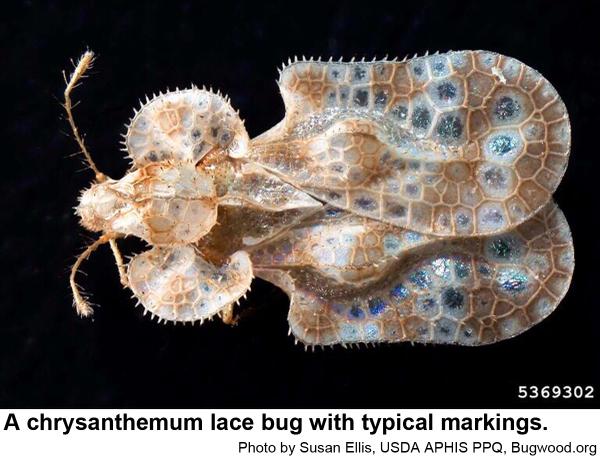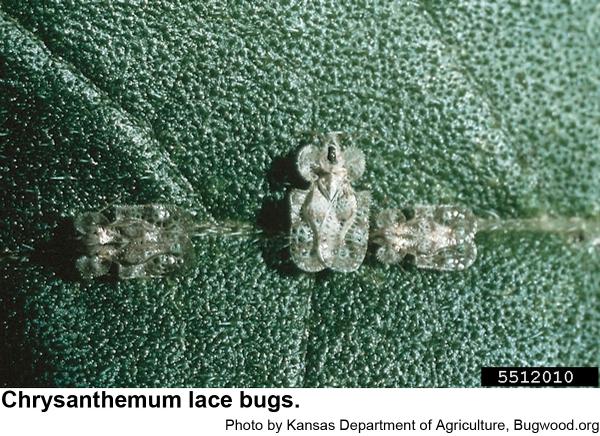Description and Biology
The chrysanthemum lace bug, Corythuca marmorata, is an occasional pest of chrysanthemums where these small (1/8 inch long), lacy adults and tiny, spiny nymphs feed on upper and lower surfaces of leaves. Mature bugs have black bodies with yellowish antennae and legs. The feet are brownish. The top has a noticeably inflated thorax (the hood), and the wings and hood are covered by small, transparent cells that resemble lace.The wings have four irregular smoky-brown bands although these markings are variable. The markings of males are usually more intense. Females insert their tiny, dark brown eggs into the leaf until only the conical, yellowish cap is visible. Eggs are usually placed along the larger veins in groups of 4 to 75, and the eggs are covered by a dark brown varnish-like excretion. From the eggs hatch minute nymphs that develop through five stages before finally molting to the adult stage. Nymphs often cluster together in groups of 6 to 100. These lace bugs overwinter in dry leaves, under stones, in grass clumps, and other sheltered debris.
Host Plants
Chrysanthemum lace bugs are sometimes noticeably abundant on mums, asters, golden rod, ragwood, sunflower and other plants in the aster family. When abundant, chrysanthemum lace bugs cause noticeable to severe, pale speckling on leaves.
Residential Recommendations
If they are like other lace bugs in the landscape, chrysanthemum lace bug eggs are plagued by tiny parasitic wasps. Predaceous bugs may also reduce populations. However, these natural control agents may fail to prevent noticeable damage. Lace bugs can be relatively difficult to control. Perhaps this is because the eggs are inserted into the leaf tissue and covered with a drop of varnish-like excrement and are thereby protected from insecticides. It is a good idea to monitor mums for the first signs of damage. Orthene is relatively effective for lace bug control, but it is somewhat harsh on predators and parasites. Insecticidal soaps and horticultural oils are toxic to nymphs and adults, but they do not kill eggs nor do they provide any residual control (and thus are safer for parasites and predators). Safari and imidacloprid are systemic insecticides that can be applied to the soil surface to kill the lace bugs above. Chrysanthemum lace bugs should be susceptible to most contact pesticides labeled for landscape use.
Other Resources
- Chrysanthemum lace bug found on asters. Kuack, D. 2011. Greenhouse Management.
- The Lace Bugs (Hemiptera: Tingidae) of North Carolina and Their Hosts. Horn, K. F. et al. 1979. North Carolina Agricultural Experiment Station Tech. Bul. No. 257.
- The Tingoidea of New England and their biology. Bailey, N. S. 1951. Entomologica Americana 31 (new Series). 140 pp.
- The Tingitoidea of Ohio. Osborn, H. and C. J. Drake. 1916. Ohio Biological Survey Bulletin 8: 213-251.
- NC State Extension Plant Pathology Publications and Factsheets
- NC State Horticultural Science Publications
- North Carolina Agricultural Chemicals Manual
For assistance with a specific problem, contact your local N.C. Cooperative Extension center.
This factsheet has not been peer reviewed.
Publication date: Dec. 16, 2019
Reviewed/Revised: Dec. 16, 2019
Recommendations for the use of agricultural chemicals are included in this publication as a convenience to the reader. The use of brand names and any mention or listing of commercial products or services in this publication does not imply endorsement by NC State University or N.C. A&T State University nor discrimination against similar products or services not mentioned. Individuals who use agricultural chemicals are responsible for ensuring that the intended use complies with current regulations and conforms to the product label. Be sure to obtain current information about usage regulations and examine a current product label before applying any chemical. For assistance, contact your local N.C. Cooperative Extension county center.
N.C. Cooperative Extension prohibits discrimination and harassment regardless of age, color, disability, family and marital status, gender identity, national origin, political beliefs, race, religion, sex (including pregnancy), sexual orientation and veteran status.


